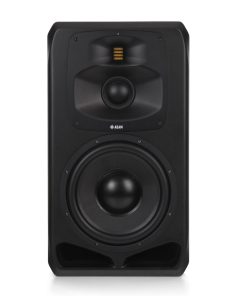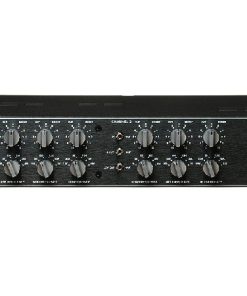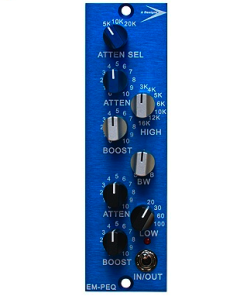IK Multimedia Saturator X Plug-In IK Multimedia
$ 79,99 $ 39,99
Analog character for your digital soul
Welcome to perfect analog color and saturation
Tube saturation. Tape saturation. Transformer coloration.
If you’ve worked on audio projects in the analog domain, you’re familiar with these concepts. You know what they are, what they can do to a track or recording, and how to get them to work their magic.
The effect of Saturation, or the introduction of harmonic distortion, on an audio track or mix can add that certain special “flavor” and “warmth” that only magnetic tape, tubes, transformers or transistors can deliver.
The T-RackS Saturator X delivers that classic analog saturation and takes you on a trip back in time to the birth of “modern” recording before computers and opens your recordings to the mysterious, elusive and warm world of analog saturation.
Comprehensive Warmth and Growl
T-RackS Saturator X is a comprehensive tool for adding analog flavor to your recordings. From tape to tube to transformer to transistor, it provides you with options — 10 individual styles of saturation and distortion from the gentle, subtle hint of drive from a slightly overdriven transistor to the full-on wooly nasty in-your-face mayhem of tubes driven to beyond their limit… and everything in between. T-RackS Saturator X delivers.
Saturator Operator
T-RackS Saturator X is intuitive and extremely easy to use. It works as a plug-in on the individual tracks in your mix or as part of the T-RackS chain.
It works by imparting distortion into the digital processing which by its nature doesn’t typically change or alter the linearity of the frequency response and harmonic pattern of a signal.
The introduction of distortion simulates the way analog circuitry behaves especially when pushed beyond its limit.
The controls on the Saturator X are pretty straightforward: Input Gain, Ouput drive (can be independent or inverse linked controls), Saturation mode select, Brickwall limiter engage and Oversampling select.
The Input Gain and Output level controls can operate as individual controls, allowing you to freely adjust how much saturation effect is applied and how loud the effect appears in the mix. You can also “inverse link” the two and maintain the ratio of input gain to output volume. This lets you set your overall perceived volume, lock it in, then adjust the amount of saturation applied without changing the output level.
10 modes of Analog
Each of the 10 saturation modes accurately delivers the behavior of the analog hardware component and circuitry or medium, selected for its peculiar character.
The palette of available tones varies from the very subtle “color” of the transformers, which offer a super light change in frequency response and only a hint of breakup towards the very top end of the gain range, to more pronounced and downright “nasty” distortion as in tubes or solid states circuit designs.
The modes include:
Tape 1
This mode reproduces the classic character and high frequency compression of an analog tape machine reaching saturation when pushed above normal recording levels.
Tape 2
Similar to Tape 1 in terms of typical uses, this mode reproduces a more “Lo-Fi” analog tape response with more pronounced distortion and high frequency roll-off.
Master +6dB
This is a digitally-recreated soft saturation curve that can be very useful when mastering finished tracks to add RMS level and “body” to a somewhat weak-sounding mix.
Master + 12dB
This is similar to Master +6dB but with a more pronounced soft-saturation curve to make the effect even more prominent.
Tube 1 – Push Pull
This mode produces classic tube saturation with odd harmonics added by the symmetrical clipping of the Push/Pull electronics. This creates a punchy distortion that can make everything sound warmer if used lightly or with an aggressive edge when pushed.
Tube 2 – Class A
This mode produces tube saturation with more even harmonics added by the asymmetry of the Class A design. When used gently on stems or a finished mix, it adds a beautiful “halo” to the audio that is processed, definitely making it sound more analog.
Solid State 1 – Push Pull
Same as the Tube mode, but with the more aggressive character of the solid state circuitry. This mode is best used when transients need to be preserved.
Solid State 2 – Class A
Same as the Tube mode but with the more aggressive character of the solid state circuitry. This mode adds the same kind of magic “halo” the Tube Class A provides but with a more defined transient response.
Transformer – Iron
This mode reproduces the very subtle color of iron core transformer harmonic enhancement which features less even harmonics. This mode adds a very gentle and subtle saturation adding an slight amount of distortion.
Transformer – Steel
This mode reproduces steel core transformer behavior. The difference with the iron is that it provides almost equal amount of odd and even harmonic enhancement. This mode adds a very gentle saturation introducing only a slight amount of distortion.
Magic Eye Metering
Saturator X also features a “Magic Eye” VU meter that quickly gives you a visual indication of the amount of saturation being applied to the incoming signal. This style of VU meter replicates the vintage tube indicators and will instantly transport you back in time.
Never “Over” — Brickwall Limiter
TSaturate at will without clipping. When engaged, the Brickwall Limiter makes sure you’re never into digital clipping land. — that’s a distortion no one wants to hear. The Saturator X Brickwall Limiter has no user adjustable controls, it is simply the gatekeeper to ensure that your tracks or mixes never ever wander off the path.
Oversampling
Saturator X also features an “Oversampling” effect that allows you to choose the oversampling multiplier you’d like to add to your signal. Oversampling provides a higher definition “picture” of your audio by providing a better rendering of the harmonics pattern and overall quality of the processing.
Track or Master
Saturator X is at home on individual tracks where you can use it as a creative tool to add dimension, depth and a “warm and fuzzy” analog feel, or pushed to extreme limits saturation for artistic application. Use it on the master fader where gain can applied more judiciously to give it the character of an analog stage, be it tube, transistor, solid solid state or a tape deck.
Specs
- Works within the T-RackS CS Standalone application and as plug-in
- High-quality oversampling
- High-precision and high-transparency digital processors
- Accurately analog-modeled vintage classic devices
- Full-latency compensation support
- Supports sampling rates up to 192 kHz
- DSM™ and SCC™ proprietary IK technologies for extremely accurate digital models of analog hardware devices
- Native compatibility with 64-bit applications and operating systems
System Requirements
T-RackS 5 is a 64-bit application and requires a 64 bit CPU and Operating System.
Mac® (64-bits)
Minimal: Intel® Core™ 2 Duo, 4 GB of RAM (8 GB suggested), macOS 10.10 or later.
Supported Plug-in formats (64-bit): Audio Units, VST 2, VST 3, AAX.
Windows® (64-bits)
Minimal: Intel® Core™ 2 Duo or AMD Athlon™ 64 X2, 4 GB of RAM (8 GB suggested), Windows® 7, Windows® 8 or Windows® 10. Requires an ASIO compatible sound card.
Supported Plug-in formats (64-bit): VST 2, VST 3, AAX.
NOTE: EQual processor requires an OpenGL 2 compatible graphics adapter.
Internet connection is required as all of the Custom Shop operations are web based.
Prompt Delivery and Professional Packaging
Our long-standing partnership with UPS FedEx DHL and other global carriers lets us offer a range of shipping services. Our warehouse staff is extremely skilled and will package your items according to our precise and exact specifications. Your goods will undergo an extensive inspection and be safely packaged prior to being sent out. Each day, we ship to thousands of customers in many countries. The fact that we are committed to becoming the biggest online retailer in the World is clear. These warehouses are in Europe in the same way as they are in USA.
Note: Orders that include more than one item are assigned a processing period depending on the item.
Before shipping, we will inspect thoroughly the items you have ordered. Most orders are shipped within 48 hours. Expected delivery time is between 3-7 days.
Returns
Stock is dynamic. It's not entirely managed by us since we are involved with multiple entities, including the factory and the storage. The actual stock can change at any moment. It is possible that your order may be out of stock once the order has been placed.
Our policy lasts for 30 days. We cannot exchange or refund your order if it has been 30 days from the date of purchase.
For your item to be returned it must be in its original packaging, unopened and in the condition you received it. The item must be in its original packaging.
Related products
Recording Equipments
Monitor Systems
Mic Preamp
Accessories
Monitor
Monitor
Recording Equipments
Equalizers
500 Series
Recording Equipments
Monitor Systems
Recording Equipments
Microphones
Accessories
Monitor
Microphones
Monitor Systems
Equalizers
Headphones
Microphones
500 Series
Monitor Systems
Monitor Systems
































































